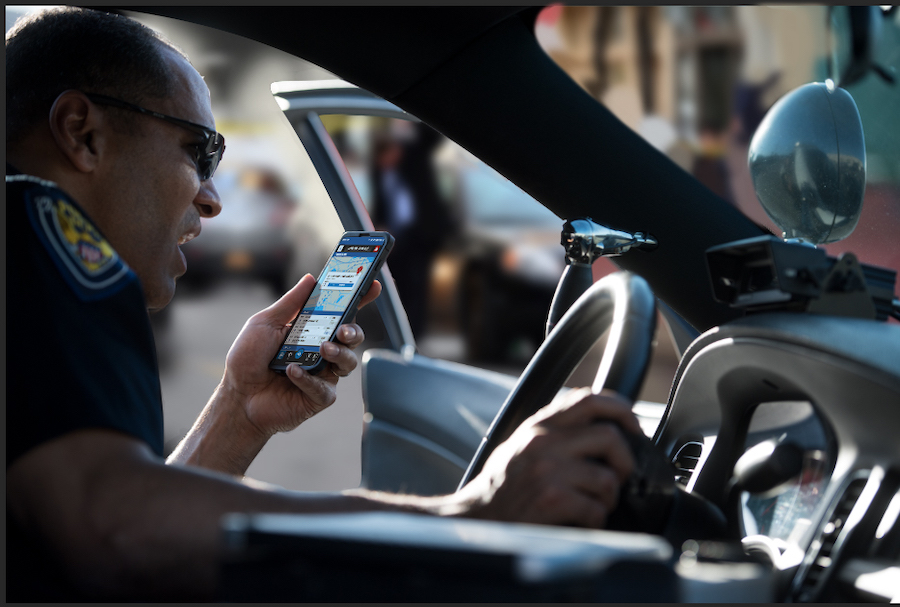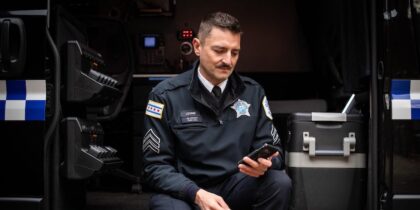The emerging technology capabilities for public safety are unlike anything we’ve seen before, and there is a new paradigm quickly evolving. This shift is being driven by a confluence of reliable and prioritized cellular networks, ubiquitous use of smartphones, the internet of things (IoT) and the rollout of 5G. The result will be a dramatic increase in situational awareness and the ability to proactively engage and prevent, rather than simply respond after the occurrence of a tragic incident.
When it comes to advancing situational awareness capabilities for law enforcement, Blueforce Development is an industry leader and a valued Samsung partner. The company, headquartered in Massachusetts, was established in 2005 by Michael Helfrich, who says the company’s mission is to “increase operational efficiency and bring these folks home at night.”
The 5G First Responder Lab Experience
Blueforce Development received a unique opportunity to advance that mission when it was selected to participate in the 5G First Responder Lab that was launched in November 2018 by Verizon and Responder Corp. The lab will serve as an innovation incubator to give forward-thinking companies access to 5G technology, so they can develop, test and refine 5G solutions for public safety.
Migrating to FirstNet®: The Definitive Guide
Get a comprehensive guide to migrating to FirstNet®, the network dedicated to public safety. Download Now
Over the course of one year, three cohorts — each comprised of five companies — will work in the lab for a period of three months. Blueforce was part of the first cohort, which completed its three-month session in July 2019 and is continuing collaborative efforts with the cohort participants. The 5G Responder Lab experience provided Blueforce with both a participatory role and the opportunity to see the synergistic potential when the above technologies are brought together. “We were elated to have been selected for the 5G First Responder Labs cohort, and the learnings and experience have been priceless,” said Helfrich.
Blueforce Development Products Enhance Situational Awareness
Blueforce Tactical and Blueforce Command are complementary products that have already proven their ability to improve situational awareness and response capabilities for public safety. Both leverage the power of Samsung’s smartphones and tablets to connect people, sensors and services, and improve operational effectiveness and safety.
Blueforce Tactical can integrate any external sensor with a functional API and provide user-determined information in a real-time continuous feed, or trigger an alert based on a preconfigured threshold. Available information includes data such as user location, status, individual operator pulse rate, galvanic stress indication, firearm status (e.g. out of holster), radiation detection and poison gas exposure, as well as on-demand camera feeds and photo sharing. Allowing user-configured alerts prevents sensory overload from too much information.
Blueforce Command supports an on-scene commander who is working out of a vehicle or command post. It operates on Windows or HTML5 client computing platforms and consolidates multiple sources of real-time information into a single-pane-of-glass view. Blueforce Command intelligently combines information from deployed personnel, body-mounted or unattended sources, as well as camera feeds, autonomous agents and other information services. This approach supports solid and timely decisions based on synchronized, real-time information.
Blueforce Tactical and Blueforce Command can be scaled and are compatible with multiple types of mobile technology, thus supporting small- or large-scale efforts in missions ranging from search and rescue to tactical entry.
Big Changes Brought by 5G
Much of the 5G discussion focuses on speed and moving data faster. Helfrich maintains the greater benefit is that the right information is being moved to the right first responder. “We’re able to realize a level of computing power that helps us to make sense of the data before we actually push it to the first responder,” said Helfrich. “It’s more contextualized and this means we can push useful data to those who need it.”
Helfrich says there are three major areas where significant new capabilities will be realized as a result of 5G:
1. Multiaccess Edge Compute (MEC) processes sensor data without going to the cloud: This is a game-changing concept because MEC distributes computing power near the end user rather than relaying processing tasks to the cloud. Much greater efficiencies of information processing are realized when artificial intelligence and/or machine learning are processed at a local level rather than being pushed to a cloud environment. Network congestion is reduced, and execution performance of apps is near real time.
Helfrich noted that during the Verizon 5G Labs experience, he saw a dramatic improvement when moving imagery was analyzed on the MEC. “We saw one use case where face detection and sentiment went from 26 seconds using 4G and the cloud, to under 10 seconds using local compute and local distribution to requesting responders,” he said.
For those situations where greater review or computing is needed, intelligent processes can make that determination. In other words, keep it local and fast when you can, and go to the cloud only when needed for an additional level of processing or analysis. “Something that’s really exciting is the potential for the MEC to serve as an aggregator of proximate resources, empowering the field commander with information that might otherwise have been unknown or missed,” Helfrich explained.
2. A superior multimedia experience and higher quality provide more information: Even with 4G/LTE, the video from a FLIR thermal imager on a helicopter or a remote surveillance position can skip frames, stutter or become grainy. The raw speed of 5G, which virtually eliminates latency, will greatly improve the quality of live video. Moreover, higher resolution sensors that exceed 720p or 1080i can be used, providing added detail that previously would have been lost. This can be incredibly important when looking at a subject thought to have a firearm or when using facial recognition.
The added capability of 5G will mean that higher resolution sensors like millimeter wave (mmWave) imagers, which can pick out a subject at great distances in low light, will yield sufficient image definition to support using them as an unattended ground sensor rather than requiring around-the-clock, hands-on operation and monitoring. “It’s really about higher resolution and more fidelity than anything we could have accomplished with 4G,” said Helfrich.
3. Cross sensor cueing produces a synergy with complementary sensors: According to Helfrich, this is an area where the possibilities are just beginning to be understood, because it takes 5G to make the concept practical. Cross sensor cueing refers to a situation where one sensor tells a second sensor (often from a different vendor) to execute an action or initiate a process. Conventional 4G transmissions would generally introduce a few seconds of latency during which the situation could change, making the action of the second sensor inconsequential or causing erroneous information to be provided.
For example, suppose a ground sensor detects vibration and notifies a camera to pan/tilt/zoom to cover the affected area. With 4G, the subject may no longer be in the area. With 5G, the subject is captured on video in near-real time and the image is sent to a decision maker or reviewed by AI for criteria such as carrying a satchel or a weapon. Helfrich pointed out that orthogonal sensor cueing will play a key role in driverless vehicles and other autonomous platforms. “Speed and low latency in these situations are paramount given the needs for info processing, machine learning and then sending commands back to a vehicle,” he said.
Integration of Sensors and Smart Cities
Cities are increasingly embracing a “smart” approach, where communication and information technologies are used to provide greater capabilities and awareness. One innovative way to do this is to use sensors to provide notification of certain situations, such as the sound of gunfire. Canton, Ohio recently announced that they will be replacing their existing gunshot detection system with a new approach that places small distributed sensors in city-controlled streetlamps. The modular system is networked to a MEC fusion point, where a sophisticated algorithm determines the likely location of the gunshot.
Helfrich noted that the streetlamp approach allows for additional sensors to be installed for specific needs, providing more flexibility in deployment. “A lamp near a chemical plant could have a chemical sensor, whereas a lamp near an aging nuclear facility could have a gamma-radiation sensor,” he explained. “In problem areas, a camera could be installed that could be used to detect a gathering crowd or even a subject carrying a weapon.
“Each streetlamp has a small computer which is networked to a gateway with a MEC that sorts through the data. That MEC is running Blueforce, and that’s where the heavy lifting takes place,” Helfrich said, adding that every notification is based on user criteria and is immediately actionable.
Assessing Deployment Options
Smartphones have already proven their value in policing through the sheer utility they provide to officers in the field. Pushing actionable information to officers based on real-time sensor data will make police operations more efficient, serving as an effective force multiplier and improving situational awareness. The rollout of 5G will dramatically advance the gains we’ve already seen.
Agency leaders who want to take advantage of the capabilities outlined in this article should begin by assessing their current situation and determining viable options. Following are suggested first steps:
- If you don’t currently have a robust smartphone deployment supporting your officers, get started with The Ultimate Law Enforcement Guide to Going Mobile, a free resource that clearly outlines important considerations. Decision makers should also consider that devices like the Samsung Galaxy S10 and Note10 introduce the opportunity to support in-vehicle computing with Samsung DeX. Using DeX, a single computer-aided dispatch (CAD)-enabled smartphone supports the operational and data query needs of an officer in the field, in the cruiser and in the station, resulting in cost savings and greater overall efficiency. Chicago Police recently announced they are rolling out a pilot of Samsung’s DeX in Vehicle solution.
- Check with the cellular carrier used by your agency to determine the timing of 5G service in your area. This will vary significantly around the country, and the initial deployments will be in high-volume service areas. If your area is moving to 5G, review your current smartphone deployment and determine timing for device replacement. You’ll need a 5G-capable device such as the Samsung Galaxy S10 5G or Note10 5G.
- Check with other service departments within your jurisdiction, especially in the area of transportation and planning, because these are commonly the first to embrace a smart city approach. If there is an effort underway, look for ways to partner and take advantage of infrastructure that may benefit public safety. For instance, cameras that monitor intersections and tie into signal optimization could be dual purposed for public safety, including expediting emergency vehicle response. If a smart city effort is not already underway, start the discussion.
- Work with your supporting IT personnel to ensure that they have awareness of the capabilities made possible by 5G and can begin to plan for implementation of systems that can take full advantage of this technology. This is an evolving area where new opportunities are continually being realized.
A fundamental shift is taking place as law enforcement leaders increasingly embrace the smartphone as a must-have tool for their personnel — one that provides a level of undeniable utility. The departments that have recognized this potential are moving ahead. Those that do not are risking missed opportunities to provide a higher level of service to their citizens and improved safety for their officers.
Visit Samsung’s Mobile First Responder page to learn more about empowering officers in the field and improving situational awareness. Use our calculator to see how much your agency could save by utilizing Samsung DeX in Vehicle.









